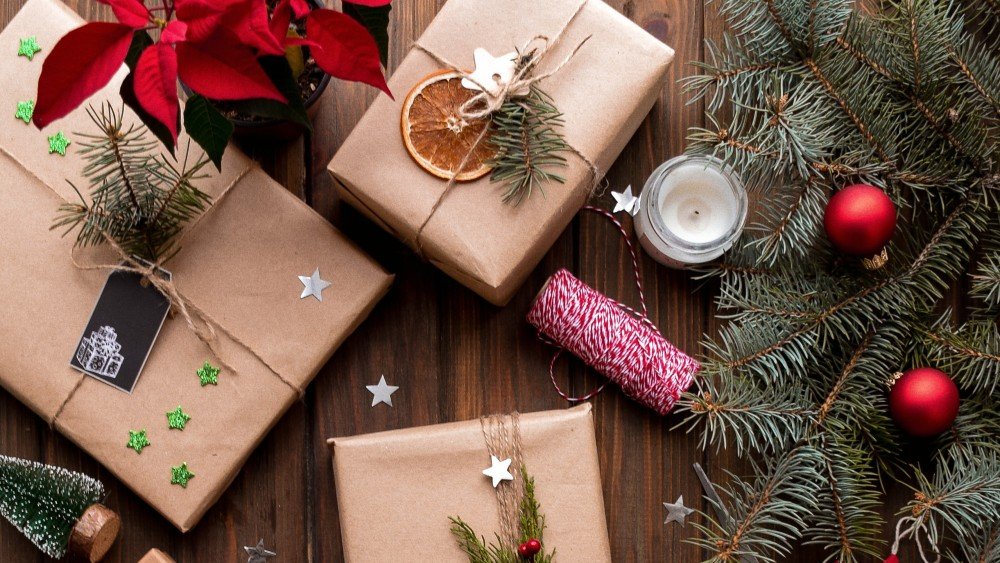Can You Wrap Christmas Gifts Sustainably?

Sustainable gift ideas are just half the process of making Christmas presents as eco-friendly as possible. Wrapping paper is one of the biggest contributors of holiday waste, which amounts to an additional 1 million tons of waste per week in landfills.
It’s why a lot of websites push for experience-based gifts to forgo the packaging and shipping of gifts at all.
The good news is there are ways of wrapping Christmas gifts sustainably, and some don’t even call for cutting out wrapping paper out entirely.
Is Christmas wrapping paper environmentally friendly?
It’s easy to think that wrapping paper is easily recycled, but it’s not always the paper itself that stops it from being recyclable.
Sticky tape isn’t recyclable, as it’s made from polypropylene, a plastic polymer. Even paper-based sticky tape uses a pressure-sensitive adhesive largely made from plastic-based ingredients like acrylic resin or vinyl.
We all have that one friend or relative who uses too much sticky tape, covering all the gaps and edges, until we’re struggling to resist the urge to grab some scissors. But how many of us remove all of the sticky tape from the wrapping paper before putting it in the designated wrapping paper bag?
I know I’m guilty of this.
The problem with sticky tape on wrapping paper is that it stops or slows down recycling facilities, as workers need to remove anything non-recyclable. In some places, all the wrapping paper might be thrown out and sent to a landfill to save time and focus on actually recyclable materials.
Contamination of recyclable materials is one of the biggest problems in ensuring proper recycling. That’s why it’s so important to check what your local government says can and can’t be recycled!
Assuming you manage to remove all of the sticky tape, the problem doesn’t end there.
That’s because the glossy, shiny, reflective paper isn’t actually paper – it’s a plastic film, sometimes coated with aluminum.
Some recycling facilities don’t accept wrapping paper at all, because wrapping paper can be dyed, laminated, or made from other materials (especially glitter and plastics). While wrapping paper makes up a lot of holiday waste, it’s not always ideal for recycling.
Recycling paper involves washing to remove inks, plastic film, and glue before being added to water to create slurry. When poured into thin sheets and dried, it can be rolled up and cut into new paper.
Small or weak paper fibers make for lower-quality recycled paper. Thin sheets of wrapping paper don’t contain many good-quality paper fibers, so the amount that can be salvaged and recyclable is lowered.
Recycle Now recommends scrunching up wrapping paper to determine how recyclable it is. If the wrapping paper resists being crumpled up, it’s generally not recyclable.
That’s why we need to reduce the amount of wrapping paper we use and throw out.
Why is wrapping paper bad for the environment?
Like most forms of packaging, wrapping paper generates a lot of landfill waste, taking up valuable space and further increasing the number of mummified materials causing more methane to be released into the atmosphere.
It’s estimated that the UK alone uses enough wrapping paper to reach the moon.
Approximately 50,000 trees are cut down to produce enough wrapping paper for the UK, with a further 30 million trees cut down to supply the US with gift wrap.
Cutting down on wrapping paper is the least we can do.
Being sustainable with our choices is also important, but educating ourselves on what can and can’t be recycled can help facilities by reducing contamination.
Are there sustainable Christmas wrapping paper alternatives?
There are a number of sustainable Christmas wrapping paper alternatives that can be used instead of purchasing wrapping paper. Some might involve buying materials, but others focus on what you already have and reusing it before it can be recycled as well.
One thing to keep in mind is to focus on either reusable or recyclable alternatives. Wrapping paper is already single-use gift wrap, and that’s what we’re trying to stop. The best alternative is one that you can use over and over again before recycling!
The most sustainable Christmas wrapping paper alternatives are:
- Reusing wrapping paper
- Using newspapers or brown recycled paper
- Putting presents in gift bags
- Wrapping gifts with fabric cloths (furoshiki) that can be reused
- Reusable Christmas bags (like Aspiga’s fabric scrap gift bags)
- Tissue paper
If you’re able to store wrapping paper, try to salvage as much as you can. By pressing it flat in a drawer or box somewhere, you can bring the box out and use it for any wrapping occasion.
You can do something similar with newspapers you own. Instead of tossing them in the recycling, save what you can to use as wrapping paper. This is especially ideal if you’re into arts and crafts – you can use the newspaper for all sorts of craft projects or to cover an area when painting.
Brown kraft or recycled paper is a more recyclable alternative to wrapping paper, as they’re easier to recycle.
San Francisco’s Department of the Environment recommends wrapping presents in a reusable bag. Gift bags are usually made from paper, but like wrapping paper it’s common for them to be decorated with non-recyclable materials like glitter or shiny paper. This still makes them a better alternative to wrapping paper provided that they’re reused continually.
An even better alternative to gift bags are fabric bags.
Aspiga, an ethical and sustainable fashion company, sells sustainable gift bags that use leftover fabrics.
The fashion industry creates a load of leftover fabric offcuts every season, so using them to package presents can help make the most of the material. You could use them as a bag for daily use as well.
And you can even make your own fabric gift bags!
Treasurie and Handmadiya have tutorials on two very different styles of gift bags. If you have your own fabric offcuts, why not give it a try to use them up?
Furoshiki is a Japanese cloth-wrapping technique you can use with leftover fabric as well.
You can follow these instructions to wrap for easy carrying or wrap boxes. There are even more methods shown in this furoshiki guide.
If you don’t have enough fabric, try stopping by a charity or thrift store. You could also cut up old blankets.
Tissue paper can be used like recycled paper or newspaper, but instead of recycling it you’d need to compost the tissue paper after. Ideal when gifting inside your own household or to someone with a compost heap, but it might not be for everybody.
But the most sustainable way to wrap Christmas gifts is to not wrap them up at all! Especially if you’re using a reusable bag to deliver them already.
How to wrap presents sustainably
When planning to wrap presents, think about what you have already first.
Once you’ve used any leftover wrapping paper, move on to the next method and find the most sustainable and convenient alternative for you!
When using any form of paper, forget the tape and use string instead. You can fold paper the same way you’d wrap it with wrapping paper and fasten it with string.

Plant-based sticky tape is a bit better, or you can use washi tape, which is made out of rice paper.
How do you wrap presents without wrapping paper?
When it comes to wrapping presents sustainably, the choice of paper or container isn’t the only concern. You also need to make sure that you’re using gift tags and any accessories like ribbons sustainably.
For gift tags, the best option when wrapping with any kind of paper is to simply write it on. Grab a sharpie and write on the wrapping paper itself, so it can be easily recycled.
Another popular suggestion is to cut up old Christmas cards. The front half of a Christmas card usually doesn’t have any text on it, and with some planning you could make six, nine, or even more gift tags out of one card. Then slip the gift card under the paper or secure it with a small bit of sticky tape. This also works for paper gift bags.
If you feel that your gift doesn’t look festive enough, don’t rush for the glitter or ribbon. Most ribbons are plastic-based, and glitter is just microplastics. While you can buy eco-friendly glitter, it’s not worth the fuss, and most people aren’t fond of spilling glitter everywhere!
Instead, consider that most people don’t look at the packaging used for gifts and make a point of pushing on its reusability or recyclability.
Greenpeace recommends swapping out wrapping paper for old magazines, but these can’t always be recycled. You could transform them into gift bows instead!

